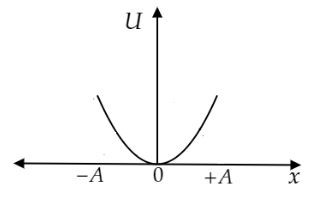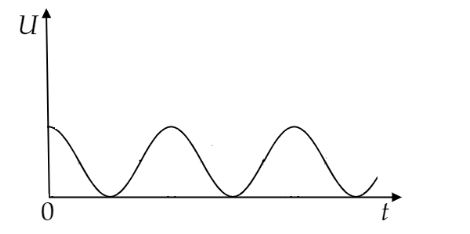
For a particle executing simple harmonic motion, the displacement $x$ is given by $x = A\cos \omega t$. Identify the graph, which represents the variation of potential energy $\left( U \right)$ as a function of time $t$ and displacement $x$.

A. I, III
B. II, III
C. I, IV
D. II, IV

Answer
472.5k+ views
Hint: The potential energy of a body in simple harmonic motion (S.H.M.) is directly proportional the square of its displacement. The potential energy is equal to the work done by the restoring force acting on the particle in S.H.M.
Complete step by step answer:
For a particle in simple harmonic motion, the force acting the particle is $F = - kx$.
Where, $k$ is a force constant and $x$ is the distance of the particle from its equilibrium position. Let $dW$be work done by the force in displacing the particle through a small distance $dx$.
$dW = - Fdx$
$ \Rightarrow dW = kxdx$
The total work done for the displacement $x$ is obtained by integrating the above equation between the limits $0$ to $x$.
$\int_0^W {dW} = \int_0^x {kxdx} $
On integration
$ \Rightarrow \left[ W \right]_0^W = \left[ {\dfrac{{k{x^2}}}{2}} \right]_0^x$
Further calculating
$ \Rightarrow W = \dfrac{1}{2}k{x^2}$
We know that the work done is equal to the potential energy of the particle.
Potential energy $U = \dfrac{1}{2}k{x^2}$
Again, $k = m{\omega ^2}$
Where, $m$ is the mass of the particle and $\omega $ is the angular speed of the particle.
Therefore, $U = \dfrac{1}{2}m{\omega ^2}{x^2}$ …… (1)
It is given that the displacement $x = A\cos \omega t$.
Substitute the value of $x$ in the above equation (1).
$U = \dfrac{1}{2}m{\omega ^2}{A^2}{\cos ^2}\omega t$ …… (2)
Now consider the equation (1).
At $x = 0$, $U = 0$ i.e., potential energy is minimum.
At $x = \pm A$, $U = \dfrac{1}{2}m{\omega ^2}{A^2}$ i.e., potential energy is maximum.
So, the variation of potential energy $\left( U \right)$ with displacement $\left( x \right)$ is shown below.

Now consider the equation (2).
Potential energy $U$ is a function of ${\cos ^2}\omega t$.
At $t = 0$, ${\cos ^2}0 = 1$ i.e., potential energy will be maximum.
At $t = \dfrac{\pi }{{2\omega }}$, ${\cos ^2}\left( {\dfrac{\pi }{2}} \right) = 0$ i.e., potential energy will be minimum.
So, the variation of potential energy $\left( U \right)$ with time $\left( t \right)$ is shown below.

Hence, the correct option is A.
Note: Simple harmonic motion is the motion in which the restoring force is proportional to its displacement from the mean position and opposes its increase. The total energy of the particle in S.H.M. always remains constant. It is shown in the below additional information.
Complete step by step answer:
For a particle in simple harmonic motion, the force acting the particle is $F = - kx$.
Where, $k$ is a force constant and $x$ is the distance of the particle from its equilibrium position. Let $dW$be work done by the force in displacing the particle through a small distance $dx$.
$dW = - Fdx$
$ \Rightarrow dW = kxdx$
The total work done for the displacement $x$ is obtained by integrating the above equation between the limits $0$ to $x$.
$\int_0^W {dW} = \int_0^x {kxdx} $
On integration
$ \Rightarrow \left[ W \right]_0^W = \left[ {\dfrac{{k{x^2}}}{2}} \right]_0^x$
Further calculating
$ \Rightarrow W = \dfrac{1}{2}k{x^2}$
We know that the work done is equal to the potential energy of the particle.
Potential energy $U = \dfrac{1}{2}k{x^2}$
Again, $k = m{\omega ^2}$
Where, $m$ is the mass of the particle and $\omega $ is the angular speed of the particle.
Therefore, $U = \dfrac{1}{2}m{\omega ^2}{x^2}$ …… (1)
It is given that the displacement $x = A\cos \omega t$.
Substitute the value of $x$ in the above equation (1).
$U = \dfrac{1}{2}m{\omega ^2}{A^2}{\cos ^2}\omega t$ …… (2)
Now consider the equation (1).
At $x = 0$, $U = 0$ i.e., potential energy is minimum.
At $x = \pm A$, $U = \dfrac{1}{2}m{\omega ^2}{A^2}$ i.e., potential energy is maximum.
So, the variation of potential energy $\left( U \right)$ with displacement $\left( x \right)$ is shown below.

Now consider the equation (2).
Potential energy $U$ is a function of ${\cos ^2}\omega t$.
At $t = 0$, ${\cos ^2}0 = 1$ i.e., potential energy will be maximum.
At $t = \dfrac{\pi }{{2\omega }}$, ${\cos ^2}\left( {\dfrac{\pi }{2}} \right) = 0$ i.e., potential energy will be minimum.
So, the variation of potential energy $\left( U \right)$ with time $\left( t \right)$ is shown below.

Hence, the correct option is A.
Note: Simple harmonic motion is the motion in which the restoring force is proportional to its displacement from the mean position and opposes its increase. The total energy of the particle in S.H.M. always remains constant. It is shown in the below additional information.
Recently Updated Pages
Master Class 12 Business Studies: Engaging Questions & Answers for Success

Master Class 12 Economics: Engaging Questions & Answers for Success

Master Class 12 English: Engaging Questions & Answers for Success

Master Class 12 Maths: Engaging Questions & Answers for Success

Master Class 12 Social Science: Engaging Questions & Answers for Success

Master Class 12 Chemistry: Engaging Questions & Answers for Success

Trending doubts
What is meant by exothermic and endothermic reactions class 11 chemistry CBSE

Which animal has three hearts class 11 biology CBSE

10 examples of friction in our daily life

One Metric ton is equal to kg A 10000 B 1000 C 100 class 11 physics CBSE

1 Quintal is equal to a 110 kg b 10 kg c 100kg d 1000 class 11 physics CBSE

Difference Between Prokaryotic Cells and Eukaryotic Cells




